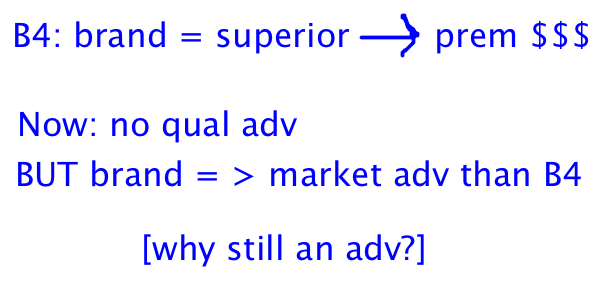-
Target Test Prep 20% Off Flash Sale is on! Code: FLASH20
Redeem
GMAT CR: Can You Fix the Discrepancy?
 The Critical Reasoning question type Explain a Discrepancy has a very specific goal. If you know what your goal is, youll be much more likely to answer the question correctly. If you dont, it can be very easy to get turned around and fall into a trap.
The Critical Reasoning question type Explain a Discrepancy has a very specific goal. If you know what your goal is, youll be much more likely to answer the question correctly. If you dont, it can be very easy to get turned around and fall into a trap.
Try this problem from the free questions that come with the GMATPrep software and then well talk about how Discrepancy questions work!
Products sold under a brand name used to command premium prices because, in general, they were superior to nonbrand rival products. Technical expertise in product development has become so widespread, however, that special quality advantages are very hard to obtain these days and even harder to maintain. As a consequence, brand-name products generally neither offer higher quality nor sell at higher prices. Paradoxically, brand names are a bigger marketing advantage than ever.Which of the following, if true, most helps to resolve the paradox outlined above?
(A) Brand names are taken by consumers as a guarantee of getting a product as good as the best rival products.
(B) Consumers recognize that the quality of products sold under invariant brand names can drift over time.
(C) In many acquisitions of one corporation by another, the acquiring corporation is interested more in acquiring the right to use certain brand names than in acquiring existing production facilities.
(D) In the days when special quality advantages were easier to obtain than they are now, it was also easier to get new brand names established.
(E) The advertising of a companys brand-name products is at times transferred to a new advertising agency, especially when sales are declining.
Got your answer? Before we dive into the solution, lets talk about what you are supposed to be doing for Discrepancy questions in the first place.
Discrepancy arguments will present some kind of surprising series of factsa paradox, to use the word that the argument above uses. The question is asking you to find a new piece of information that will resolve or fix this discrepancy. You're looking for the answer choice that provides a new fact that will cause you to say, Oh, I see! There really isnt a discrepancy at all. This new fact explains everything; the situation makes sense now.
Okay, lets dive into this problem!
Step 1: Identify the Question
How do you know that this is a Discrepancy question in the first place?
First, the question stem for this type will always contain the language if true (or a synonym). This language signals that the answers will represent new information. Be careful about crossing something off just because it seems out of scope. (By the way, three question types have the if true language in the question stem: Strengthen, Weaken, or Explain a Discrepancy.)
The question stem will also contain language asking you to explain something or to resolve a problem.
As soon as you identify the question as a Discrepancy question, you now know that youll need to articulate the actual discrepancy from the argument. Lets do that!
Step 2: Deconstruct the Argument
The first sentence indicates something that used to be true: people paid more for brand-name products because the products were better than others.
Nowadays, though, quality is a lot more equal across lots of products. Now, brand-name products are no longer higher quality and they dont cost more money.
BUT brand names are still a huge marketing advantage! That seems weird. How can that be?
Heres what my notes looked like, taken as I read the argument:
It seems like brand-name products have lost all of their advantages: theyre not higher quality and the companies cant even charge more money for them anymore. So why are brand names even more of a marketing advantage than they used to be? There must be some other advantage to a brand name that the argument hasnt articulated.
Step 3: State the Goal
On Discrepancy questions, the goal is to find an answer that fixes the discrepancy. The correct answer will cause the whole scenario to make sense.
Also, remind yourself of the most common trap on these problems: a Reverse Logic trap. Some answers will actually heighten the discrepancy, making it worse! Your job is not to make the discrepancy worse. Your job is to fix the discrepancy.
Step 4: Work from Wrong to Right
All right, lets dive in.
(A) Brand names are taken by consumers as a guarantee of getting a product as good as the best rival products.
Hmm. Consumers see a brand name as a guarantee of a certain level of quality, even if that quality isnt necessarily higher than the quality of rival products. Yes, thats an advantage. Even though companies cant charge more for brand-name products nowadays, they can sell more (in volume) since consumers still perceive an advantage to buying a brand name. This one looks good; keep it in.
(B) Consumers recognize that the quality of products sold under invariant brand names can drift over time.
I had to pause a moment over the word invariant. Its not a commonly used word. If youre not sure what it means, heres how you can decode it: vary = change. Variant = something different. In- at the beginning of a word means take the opposite meaning. For example, possible means that something can be done. Impossible means that it cant.
So if variant means something different or changing, then invariant is something that doesnt change. An invariant brand name, then, is a brand name that stays the same over time; it doesnt change. This choice is saying that a product sold under the same brand name may have drifting quality over time. Thats not good!
This is a Reverse Logic answer: it heightens the discrepancy. If consumers cant count on the quality of a particular brand-name product, then why would they be more likely to buy that product? They wouldnt. This choice doesnt go along with the idea that the brand name is a bigger marketing advantage than ever. Eliminate.
(C) In many acquisitions of one corporation by another, the acquiring corporation is interested more in acquiring the right to use certain brand names than in acquiring existing production facilities.
This certainly supports the idea that brand names are a bigger marketing advantage than ever! Its just missing one thing: it doesnt explain why this is so. Your job is to fix the discrepancy, not to support the idea that brand names are a bigger marketing advantage than ever. Someone who mistakenly thought this was a Strengthen question would likely pick this answer. Eliminate.
(D) In the days when special quality advantages were easier to obtain than they are now, it was also easier to get new brand names established.
Were trying to resolve a discrepancy that exists right now, but this choice is about something that was true in the past. That past situation doesnt apply to the present-day paradox. Eliminate.
(E) The advertising of a companys brand-name products is at times transferred to a new advertising agency, especially when sales are declining.
Im sure this happens, but it doesnt explain why brand names are a bigger marketing advantage than non-brand names. Any company could use any advertising agency for any kind of brand-name or non-brand-name product. Eliminate.
The correct answer is (A). it provides an alternative benefit that was not articulated in the argument: the brand name still has value because people trust that this product will be at least as good as other, similar products.
What did you learn on this problem? Come up with your own takeaways before you read mine below.
Key Takeaways for Discrepancy Problems:
(1) Know how to identify the question type (if true + explain, resolve, account for) and what youre trying to do: find a choice that fixes the discrepancy.
(2) What is the discrepancy in question? Articulate this clearly to yourself before you go to the answers.
(3) Watch out for trap answers. The most common trap answer on a Discrepancy question will heighten the discrepancy, not fix it. Other traps might answer the wrong question, as answer (C) did in this problem (it potentially strengthened the idea that the brand name is a bigger advantage than everbut thats not what you were asked to do!).
* GMATPrep questions courtesy of the Graduate Management Admissions Council. Usage of this question does not imply endorsement by GMAC.
Recent Articles
Archive
- April 2024
- March 2024
- February 2024
- January 2024
- December 2023
- November 2023
- October 2023
- September 2023
- July 2023
- June 2023
- May 2023
- April 2023
- March 2023
- February 2023
- January 2023
- December 2022
- November 2022
- October 2022
- September 2022
- August 2022
- July 2022
- June 2022
- May 2022
- April 2022
- March 2022
- February 2022
- January 2022
- December 2021
- November 2021
- October 2021
- September 2021
- August 2021
- July 2021
- June 2021
- May 2021
- April 2021
- March 2021
- February 2021
- January 2021
- December 2020
- November 2020
- October 2020
- September 2020
- August 2020
- July 2020
- June 2020
- May 2020
- April 2020
- March 2020
- February 2020
- January 2020
- December 2019
- November 2019
- October 2019
- September 2019
- August 2019
- July 2019
- June 2019
- May 2019
- April 2019
- March 2019
- February 2019
- January 2019
- December 2018
- November 2018
- October 2018
- September 2018
- August 2018
- July 2018
- June 2018
- May 2018
- April 2018
- March 2018
- February 2018
- January 2018
- December 2017
- November 2017
- October 2017
- September 2017
- August 2017
- July 2017
- June 2017
- May 2017
- April 2017
- March 2017
- February 2017
- January 2017
- December 2016
- November 2016
- October 2016
- September 2016
- August 2016
- July 2016
- June 2016
- May 2016
- April 2016
- March 2016
- February 2016
- January 2016
- December 2015
- November 2015
- October 2015
- September 2015
- August 2015
- July 2015
- June 2015
- May 2015
- April 2015
- March 2015
- February 2015
- January 2015
- December 2014
- November 2014
- October 2014
- September 2014
- August 2014
- July 2014
- June 2014
- May 2014
- April 2014
- March 2014
- February 2014
- January 2014
- December 2013
- November 2013
- October 2013
- September 2013
- August 2013
- July 2013
- June 2013
- May 2013
- April 2013
- March 2013
- February 2013
- January 2013
- December 2012
- November 2012
- October 2012
- September 2012
- August 2012
- July 2012
- June 2012
- May 2012
- April 2012
- March 2012
- February 2012
- January 2012
- December 2011
- November 2011
- October 2011
- September 2011
- August 2011
- July 2011
- June 2011
- May 2011
- April 2011
- March 2011
- February 2011
- January 2011
- December 2010
- November 2010
- October 2010
- September 2010
- August 2010
- July 2010
- June 2010
- May 2010
- April 2010
- March 2010
- February 2010
- January 2010
- December 2009
- November 2009
- October 2009
- September 2009
- August 2009
